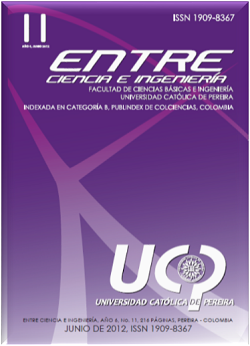Comparing the Efficiency of T2 Graphs for Hotelling and Classification by Ranking, Using Different Estimators of Location and Dispersion
Keywords:
Multivariate Control Charts, Statistics T2, Rankings Index, Estimates of Location and Dispersion, Average Run LengthAbstract
Quality is defined simultaneously by a set of correlated variables for many products or services. To monitor a multivariate process, the classic control chart T2 (Hotelling (1947)) is often used. This chart is constructed under the assumption of normality of the observations and estimates of usual location and dispersion. It is well known that this chart is very sensitive to the presence of outliers in the historical data set, causing the masking effect and therefore several proposals to construct charts T2 with alternative estimators that have become more powerful and robust charts in the presence of outliers or faster detection of change in the mean vector have been proposed.
The normality of the observations is not always true in practice, then the nonparametric control charts are recommended in this case, one of them is the chart of a ranking method (Liu (1995)). Zertuchi and Cantu (2008), Velasquez and Moreno (2009), comparing the efficiency between the two charts above using conventional estimators under normal and devoid of it. This work, presents a comparative study about the efficiency of the two charts using various estimates of the mean vector and covariance matrix, in the presence of outliers in the construction phase. The efficiency of control charts is determined by the change in the early detection of mean vector. The efficiency of charts in this study is measured calculating the average run length (ARL) under control by statistical simulation through various environments encountered. We present the results obtained with their respective interpretations and conclusions.
References
Alt, F.B y Smith, N.D. (1988). Multivariate Process Control, in P.R. Krishnaiah y C.R. Rao, eds, Handbook of Statistics, 7, North holland, Amsterdam.
Chenouri, S., Steiner, S.H. y Variant, A.M. (2009). A Multivariate Robust Control Chart for Individual. Journal of Quality Technology 41, No: 259-271.
Crosier, R.B. (1988). “Multivariate Generalizations of Cumulative Sum Quality Control chemes”. Technometrics, 30, 291-303.
Hotelling, H. (1947). Multivariate Quality Control. Techniques of Statistical Analysis, S.C Eisenhart, M.W. Hastay, y W.A. Wallis. New York: McGraw Hill.
Jensen, W.A., Birch, J.B. y Woodall, W.H. (2007). High Breakdown Estimation Methods for Phase I Multivariate Control Charts. Quality and Reliability Engineering International, 23(5), 1638-1665.
Liu, R. (1995). Control Chart for Multivariate Processes. Journal American Statistics Association. Theory and Methods. 90, No 432: 1380-1387.
Lowry, C.A.; Woodall, W.H.; Champ, C.W.; y Rigdon, S.E. (1992). A Multivariate Exponentially Weighted Moving Average Control Chart. Tecnometrics, 34, pp.46-53.
Lowry, C.A.; y Montgomery, D.C. (1995). A Review of Multivariate Control Charts. IIE Transactions, 27, 800-810.
Pignatiello, J.J. Jr.; y Runger, G.C. (1990). Comparisons of Multivariate CUSUM Charts”. Journal of Quality Technology, 22, 173-186.
Rousseeuw, P.J. y van Driessen, K. (1999). A Fast Algorithm for the Minimum Covariance Determinant Estimator. Technometrics, 41, 212-223.
Rousseeuw, P.J. y van Zomeren, B.C. (1990). Unmasking Multivariate Outliers and Leverage Points (with discussion). Journal of the American Statistical Association, 85, 633-651.
Sullivan, J.H., Woodall, W.H. (1996). A Comparison of Multivariate Control Charts for Individual Observations. Journal of Quality Technology, 28: 398-408.
Tracy, N.D., Young, J.C. y Mason, R.L. (1992). Multivariate Control Charts for Individual Observations. Journal of Quality Technology, 24, 88-95.
Vargas, J.A. (2003). Robust Estimation in Multivariate Control Charts for Individual Observations. Journal of Quality Technology, 35(4), 367-376.
Velásquez, H. y Moreno, D.P. (2009). Tratamientos a Puntos Atípicos Identificados por Gráficos de Control Multivariados. XIX Simposio Nacional de Estadística, Medellin Colombia. Comunicación.
Wierda, S.J. (1994). Multivariate Statistical Process ControlRecent. Results and Directions for Future Research. Statistica Neerlandica, 48,147-168.
Willems, G, Pison G., Rousseeuw, P.J. y Van Aelst, S. (2002). A Robust Hotelling Test. Metrika 55:125-138.
Yañez, S. Vargas, J.A., y González, N. (2003). Carta T2 con Base en Estimadores Robustos de los Parámetros. Revista Colombiana de Estadística, 26, 159-179.
Zertuchi, F. y Cantú, M. (2008). Una Comparación del Desempeño de las Cartas de Control T2 de Hotelling y de Clasificación por Rangos. Ingeniería, Investigación y Tecnología, 9, Nº 3, 205-215.
Zuo, Y. y Serfling, R. (2000). Structural Properties and Converge Results for Contours of Sample Statistical Depth Functions. The Annals of Statistics, 483-499.








 Revista Entre Ciencia e Ingeniería
Revista Entre Ciencia e Ingeniería .png) entrecei@ucp.edu.co
entrecei@ucp.edu.co.png) ISSN (Impreso) 1909-8367 - ISSN (En Línea) 2539-4169
ISSN (Impreso) 1909-8367 - ISSN (En Línea) 2539-4169 Attribution-NonCommercial 4.0 International (CC By-NC 4.0)
Attribution-NonCommercial 4.0 International (CC By-NC 4.0)
.png) Carrera 21 No. 49-95 Av. de las Américas, Pereira, Risaralda, Colombia
Carrera 21 No. 49-95 Av. de las Américas, Pereira, Risaralda, Colombia